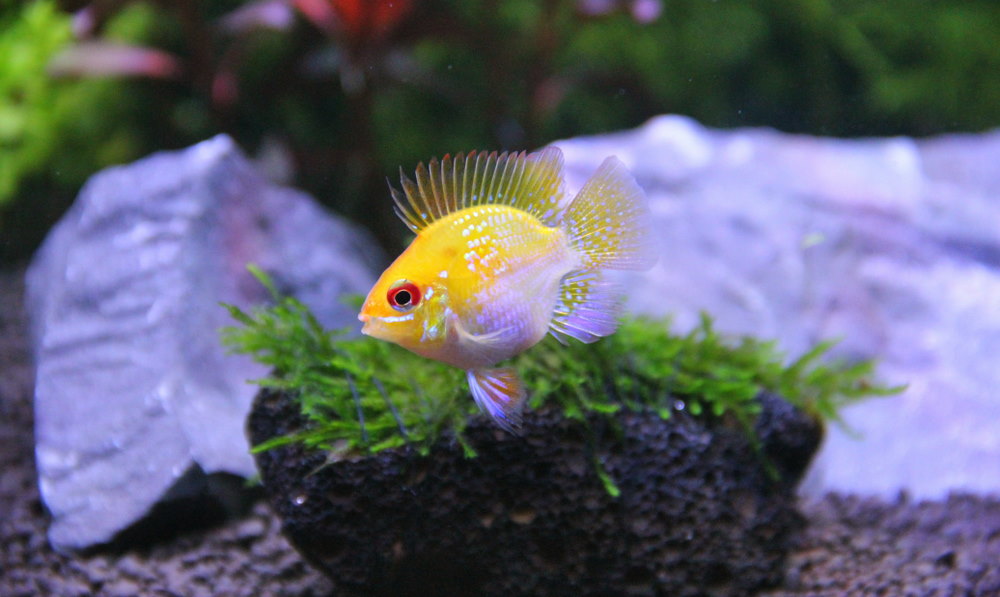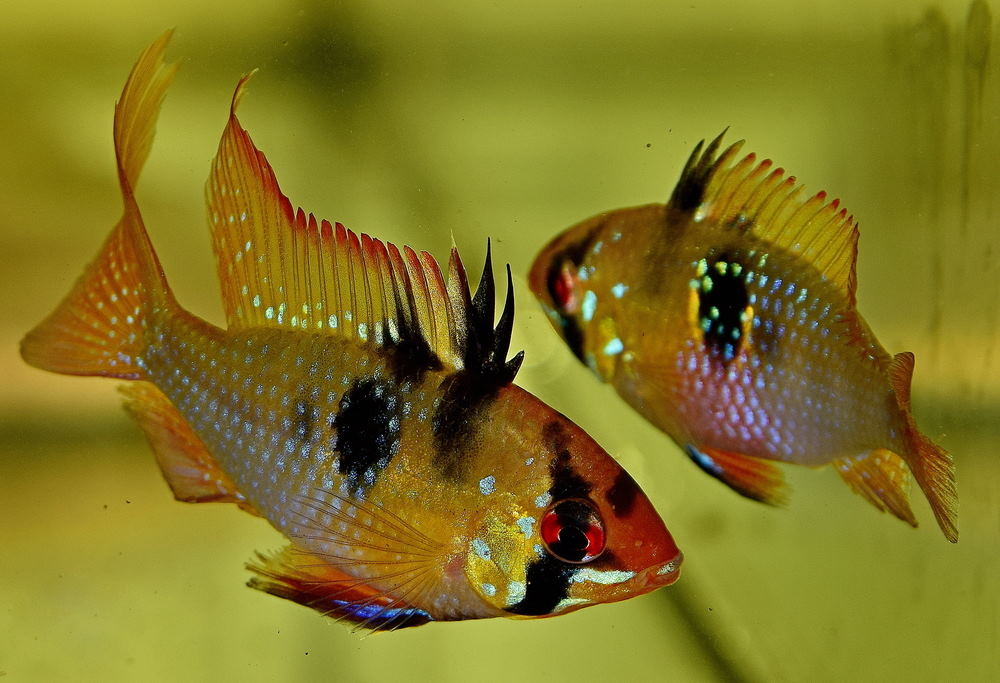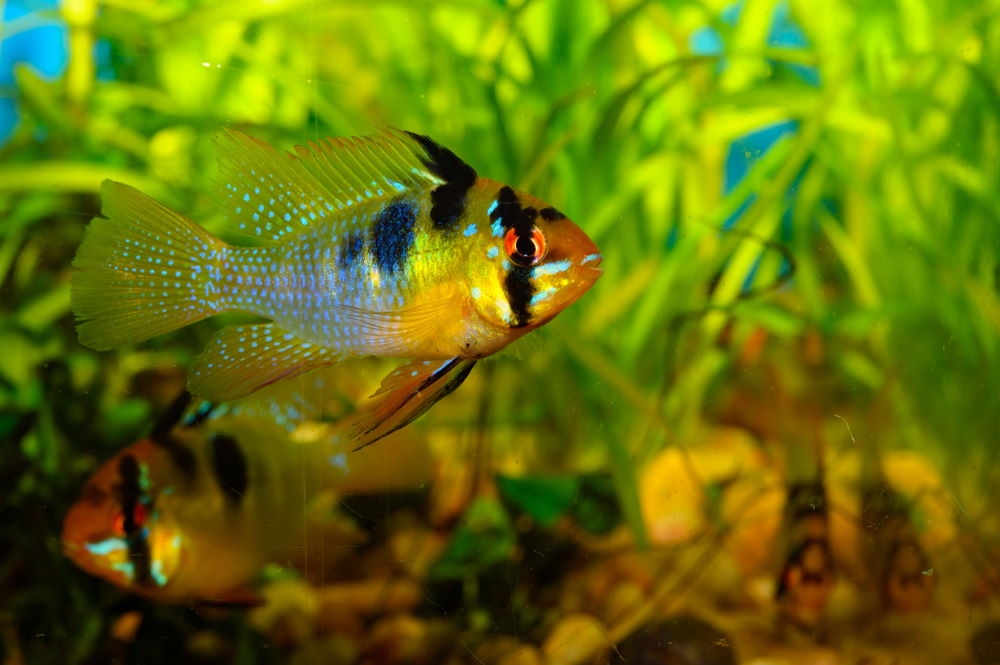Care Guide for German Blue Rams – Housing, Breeding, and More
Between their iridescent colors and confident personality, German blue ram cichlids are one of the most striking freshwater fish in the aquarium hobby. When you see a healthy ram in breeding condition, almost every hue of the rainbow is displayed. In this article, we interviewed master breeder Dean to share his decades of experience in keeping, breeding, and raising this amazing dwarf cichlid.
What are German Blue Rams?
Mikrogeophagus ramirezi is a South American dwarf cichlid that goes by many common names, including ram cichlid, blue ram, German blue ram, butterfly cichlid, and Ramirez’s dwarf cichlid.
Where do blue rams come from? Contrary to the name, ram cichlids originate from the Orinoco River basin in Colombia and Venezuela. The name “German blue” refers to a color variation of the ram cichlid that was selectively bred in Germany and became popularized worldwide in the aquarium trade.
What are the different types of ram cichlids? In terms of body shape, there are regular, long fin, and balloon rams on the market. The most common color varieties include German blue rams, gold rams, and electric blue rams. A black version of the ram cichlid has been developed recently but is still difficult to find.

This gold balloon ram has been selectively bred for its bright yellow color and shortened body shape.
How big does a German blue ram fish get? Regular-sized blue rams tend to stay between 2-2.5 inches (5-6 cm) long, which is a little smaller than their cousins, the Bolivian ram cichlid (Mikrogeophagus altispinosus).
How long do German blue ram fish live? Because of poor breeding practices or improper care requirements, ram cichlids have the reputation for being less hardy compared to other species. If given lots of high-quality foods and clean water at the right temperature (see below), they can live up to 4 years.
Where Can You Buy German Blue Rams?
Ram cichlids usually come from three sources: overseas fish farms, domestic fish farms (from your own country), or local breeders. If you purchase from a fish store, most likely the fish were imported from overseas. The cichlids may seem to have brighter colors or longer fins, but be careful because overseas farms sometimes use hormones that will artificially boost their appearance but also negatively impact their longevity. If you purchase from a domestic farm in the United States, they are often raised in Florida and may come in better condition than imported fish. The best-case scenario is to purchase from a local breeder because the rams are kept in water parameters that are more similar to yours and thus have a higher chance of thriving.
How do you pick a healthy blue ram? When shopping at a fish store, make sure to select a robust, active ram that eats well and perhaps spars with other rams over the best spawning spots. Do not choose a skinny ram, especially if it has a hollow belly. Sick rams with these symptoms rarely recover, so pick the healthiest specimens possible. If you are looking for a pair to breed, Dean recommends choosing a colorful male with extended dorsal fins and nice pectoral fins. If you can find the female he is already paired with, you have a higher chance of successful breeding. Females can be easily identified by the fact that they have tiny, bright blue dots inside the big, black spot on the side of their bodies, whereas males lack any spangling on their black spot.

The female on the right has spangling inside of her black spot, whereas the male on the left does not.
How Do You Set Up a Ram Cichlid Aquarium?
Most beginners aren’t aware that the most critical component of their husbandry involves keeping blue rams at high temperatures, ideally between 84-86°F (29-30°C). If you want to add live aquarium plants to their tank, make sure they can tolerate the hot water. Rams also like to dig, so you may want to choose plants like java fern and mosses that don’t need substrate and can be attached to rocks and driftwood.
Good water quality is also essential. Give them partial water changes at least once a week because they need plenty of fresh, clean water and are quite intolerant of ammonia and other toxins. Allowing the water quality to dip can lead to illness and potentially death. As for water chemistry parameters, rams are fairly adaptable to a wide range of pH levels, but they do better in soft water or low GH conditions. If you have hard tap water, consider diluting it with some RODI (reverse osmosis de-ionized) water or adding Indian almond leaves and driftwood to help soften the water.
How many blue rams should be kept together? A pair of rams can live in a 20-gallon community tank or in a 10-gallon breeding tank with no other fish. If you wish to keep two pairs of rams, increase the aquarium size to 40 gallons so that each set has enough territory. Give the rams several places to hide from each other in case one decides he wants to be the tank boss.
Can blue rams live alone? Yes, if you have an overly aggressive individual that doesn’t play well with others, he may be happier by himself as the leader of a community aquarium without any fellow dwarf cichlids.
Are rams peaceful fish? Like many cichlids, blue rams can be a bit feisty if the fish tank is too small or they are tending their eggs. However, they are relatively peaceful and are often kept in a community aquarium with other similar-sized fish that enjoy the same water parameters.

Ram cichlids can live in community tanks as long as the other tank mates can tolerate higher temperatures and won’t eat them.
Can blue rams live with tank mates? Yes, they can live with almost any community fish that can tolerate the same high temperatures, such as tetras, Sterbai cory catfish, plecos, discus, angelfish, and other dwarf cichlids. Just don’t put them with super-fast eaters that will outcompete them for food or larger fish (like oscars) that may consider them as food.
What do Blue Ram Cichlids Eat?
In our experience, these cichlids are not very picky, so you can feed them just about any dry food from the pet store, like sinking pellets, freeze-dried bloodworms, and freeze-dried tubifex worms. They also love frozen foods, such as brine shrimp, cyclops, bloodworms, and mysis shrimp for larger adults. Give them a wide variety of foods to ensure they get all the essential nutrients and vitamins they need to stay healthy. Dean likes to feed his rams twice a day, especially while they are growing, but once they reach adulthood, once a day is fine.
What Do German Blue Rams Need to Breed?
Odds are that if you keep a male and female together, even in a community tank, they will end up spawning somewhere (usually in a secluded corner where they can protect the eggs). However, if you want to set up a specialized breeding tank, get a 10-gallon aquarium with a lid and background to help them feel safer. Dean uses bare-bottom tanks with no substrate, but you can add some gravel if you like. Get a gentle sponge filter (or a small hang-on-back filter with a pre-filter sponge to prevent fry from begin sucked up), as well as an adjustable aquarium heater. In the corners of the tank, place various spawning sites, such as flat river stones or tiny terracotta pots and saucers. Add a large clump of java moss or java fern on wood to provide cover for the rams and to grow infusoria that the fry can feed on.

Ram cichlids breed very easily, but their eggs may get eaten by other fish and invertebrates if kept in a community tank.
Get the adults ready for breeding by feeding them high-quality foods, as well as some live baby brine shrimp every day. Dean’s thought process behind this trick is that the abundance of fry food in the water signals to the parents that it’s a good time to spawn and then they are more likely to take care of the fry. New parents may eat the first two or three spawns they lay, so if you want to save the eggs, place them in a specimen container with a few drops of methylene blue to prevent fungus growth. Once they hatch in 3 to 5 days, do a 50% water change every day to gradually remove the medication, and feed them infusoria several times a day as their first foods. If the parents can take care of the fry themselves, then your job is a lot easier. Start feeding the fry live baby brine shrimp and powdered fry foods like Hikari First Bites, and the parents will guide their babies to where the food is.
Want to learn more about another type of dwarf cichlid that is easy to breed? Check out our complete care guide on Apistogrammas.




